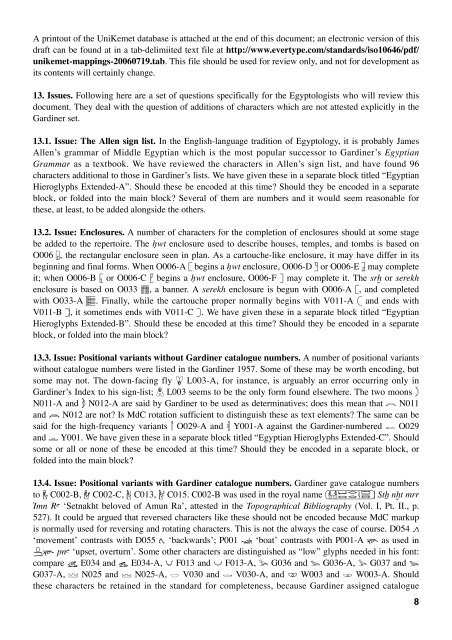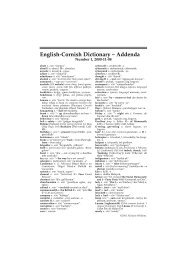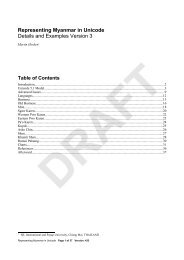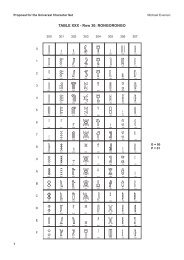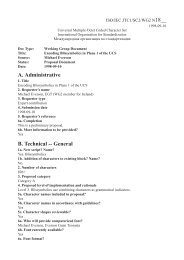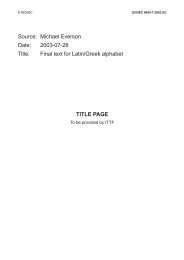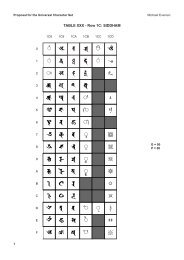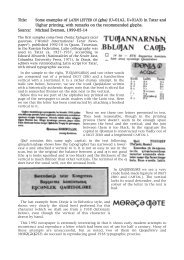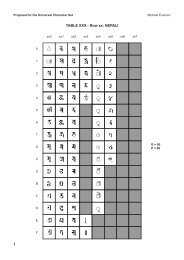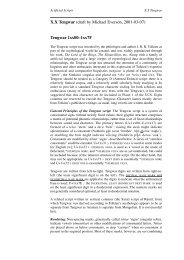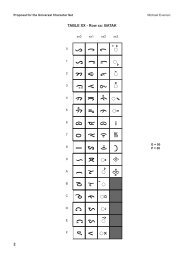Towards a Proposal to encode Egyptian Hieroglyphs in ... - Evertype
Towards a Proposal to encode Egyptian Hieroglyphs in ... - Evertype
Towards a Proposal to encode Egyptian Hieroglyphs in ... - Evertype
Create successful ePaper yourself
Turn your PDF publications into a flip-book with our unique Google optimized e-Paper software.
A pr<strong>in</strong><strong>to</strong>ut of the UniKemet database is attached at the end of this document; an electronic version of this<br />
draft can be found at <strong>in</strong> a tab-delimiited text file at http://www.evertype.com/standards/iso10646/pdf/<br />
unikemet-mapp<strong>in</strong>gs-20060719.tab. This file should be used for review only, and not for development as<br />
its contents will certa<strong>in</strong>ly change.<br />
13. Issues. Follow<strong>in</strong>g here are a set of questions specifically for the Egyp<strong>to</strong>logists who will review this<br />
document. They deal with the question of additions of characters which are not attested explicitly <strong>in</strong> the<br />
Gard<strong>in</strong>er set.<br />
13.1. Issue: The Allen sign list. In the English-language tradition of Egyp<strong>to</strong>logy, it is probably James<br />
Allen’s grammar of Middle <strong>Egyptian</strong> which is the most popular successor <strong>to</strong> Gard<strong>in</strong>er’s <strong>Egyptian</strong><br />
Grammar as a textbook. We have reviewed the characters <strong>in</strong> Allen’s sign list, and have found 96<br />
characters additional <strong>to</strong> those <strong>in</strong> Gard<strong>in</strong>er’s lists. We have given these <strong>in</strong> a separate block titled “<strong>Egyptian</strong><br />
<strong>Hieroglyphs</strong> Extended-A”. Should these be <strong>encode</strong>d at this time? Should they be <strong>encode</strong>d <strong>in</strong> a separate<br />
block, or folded <strong>in</strong><strong>to</strong> the ma<strong>in</strong> block? Several of them are numbers and it would seem reasonable for<br />
these, at least, <strong>to</strong> be added alongside the others.<br />
13.2. Issue: Enclosures. A number of characters for the completion of enclosures should at some stage<br />
be added <strong>to</strong> the reper<strong>to</strong>ire. The h. wt enclosure used <strong>to</strong> describe houses, temples, and <strong>to</strong>mbs is based on<br />
O006 ‹, the rectangular enclosure seen <strong>in</strong> plan. As a car<strong>to</strong>uche-like enclosure, it may have differ <strong>in</strong> its<br />
beg<strong>in</strong>n<strong>in</strong>g and f<strong>in</strong>al forms. When O006-A ‘ beg<strong>in</strong>s a h. wt enclosure, O006-D ÿ or O006-E Ÿ may complete<br />
it; when O006-B ÷ or O006-C ◊ beg<strong>in</strong>s a h. wt enclosure, O006-F ⁄ may complete it. The srh ˘ or serekh<br />
enclosure is based on O033 €, a banner. A serekh enclosure is begun with O006-A ‘, and completed<br />
with O033-A ’. F<strong>in</strong>ally, while the car<strong>to</strong>uche proper normally beg<strong>in</strong>s with V011-A œ and ends with<br />
V011-B —, it sometimes ends with V011-C ”. We have given these <strong>in</strong> a separate block titled “<strong>Egyptian</strong><br />
<strong>Hieroglyphs</strong> Extended-B”. Should these be <strong>encode</strong>d at this time? Should they be <strong>encode</strong>d <strong>in</strong> a separate<br />
block, or folded <strong>in</strong><strong>to</strong> the ma<strong>in</strong> block?<br />
13.3. Issue: Positional variants without Gard<strong>in</strong>er catalogue numbers. A number of positional variants<br />
without catalogue numbers were listed <strong>in</strong> the Gard<strong>in</strong>er 1957. Some of these may be worth encod<strong>in</strong>g, but<br />
some may not. The down-fac<strong>in</strong>g fly Å L003-A, for <strong>in</strong>stance, is arguably an error occurr<strong>in</strong>g only <strong>in</strong><br />
Gard<strong>in</strong>er’s Index <strong>to</strong> his sign-list; Ä L003 seems <strong>to</strong> be the only form found elsewhere. The two moons É<br />
N011-A and Ö N012-A are said by Gard<strong>in</strong>er <strong>to</strong> be used as determ<strong>in</strong>atives; does this mean that Ç N011<br />
and Ñ N012 are not? Is MdC rotation sufficient <strong>to</strong> dist<strong>in</strong>guish these as text elements? The same can be<br />
said for the high-frequency variants á O029-A and â Y001-A aga<strong>in</strong>st the Gard<strong>in</strong>er-numbered Ü O029<br />
and à Y001. We have given these <strong>in</strong> a separate block titled “<strong>Egyptian</strong> <strong>Hieroglyphs</strong> Extended-C”. Should<br />
some or all or none of these be <strong>encode</strong>d at this time? Should they be <strong>encode</strong>d <strong>in</strong> a separate block, or<br />
folded <strong>in</strong><strong>to</strong> the ma<strong>in</strong> block?<br />
13.4. Issue: Positional variants with Gard<strong>in</strong>er catalogue numbers. Gard<strong>in</strong>er gave catalogue numbers<br />
<strong>to</strong> Ô C002-B, apple C002-C, Ò C013, Ú C015. C002-B was used <strong>in</strong> the royal name ’ Sth ¯ nh ˘ t mrr<br />
ìmn RÆ ‘Setnakht beloved of Amun Ra’, attested <strong>in</strong> the Topographical Bibliography (Vol. I, Pt. II., p.<br />
527). It could be argued that reversed characters like these should not be <strong>encode</strong>d because MdC markup<br />
is normally used for revers<strong>in</strong>g and rotat<strong>in</strong>g characters. This is not the always the case of course. D054 Û<br />
‘movement’ contrasts with D055 Ù ‘backwards’; P001 ı ‘boat’ contrasts with P001-A ˆ as used <strong>in</strong><br />
~ˆ pnÆ ‘upset, overturn’. Some other characters are dist<strong>in</strong>guished as “low” glyphs needed <strong>in</strong> his font:<br />
compare ˜ E034 and ¯ E034-A, Ï F013 and Ì F013-A, ˘ G036 and ˙ G036-A, ˚ G037 and ¸<br />
G037-A, Ê N025 and Á N025-A, Ë V030 and È V030-A, and Í W003 and Î W003-A. Should<br />
these characters be reta<strong>in</strong>ed <strong>in</strong> the standard for completeness, because Gard<strong>in</strong>er assigned catalogue<br />
8


